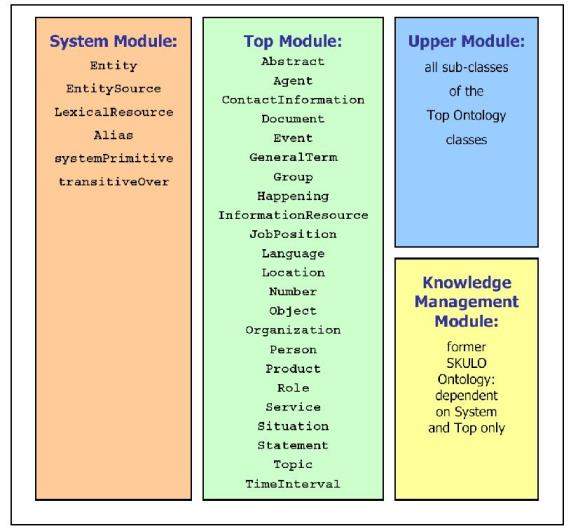3.3.1 PROTON Ontology
PROTON ontology provides coverage of the most general concepts, with focus on named entities (people, locations, organizations) and concrete domains (numbers, dates, etc.).
The design principles can be summarized as follows:
- domain-independence;
- light-weight logical definitions;
- alignment with popular standards;
- good coverage of named entities and concrete domains (i.e. people, organizations, locations, numbers, dates, addresses).
The ontology is originally encoded in a fragment of OWL Lite and split into four modules: System, Top, Upper, and KM (Knowledge Management), shown on Figure 5 below.

Figure 5 - PROTON Ontology
System module
The System module consists of a few meta-level primitives (5 classes and 5 properties). It introduces the notion of 'entity', which can have aliases. The primitives at this level are usually the few things that have to be hard-coded in ontology-based applications. Within this document and in general, the System module of PROTON is referred to via the "protons:" prefix.
Top module
The Top module is the highest, most general, conceptual level, consisting of about 20 classes. These ensure a good balance of utility, domain independence, and ease of understanding and usage. The top layer is usually the best level to establish alignment to other ontologies and schemata. Within this document and in general, the Top module of PROTON is referred to via the "protont:" prefix.
Upper module
The Upper module has over 200 general classes of entities, which often appear in multiple domains (e.g. various sorts of organizations, a comprehensive range of locations, etc.). Within this document and in general, the Upper module of PROTON is referred to via the "protonu:" prefix.
Knowledge Management (KM) module
The KM module has 38 classes of slightly specialized entities that are specific for typical Knowledge Management tasks and applications. Within this document and in general, the PROTON KM module is referred to via the "protonkm:" prefix.